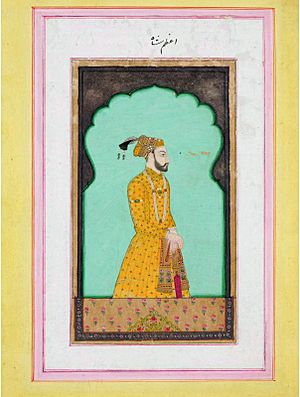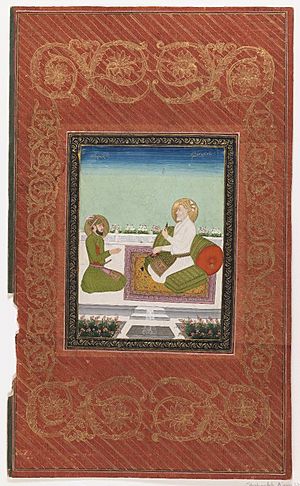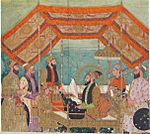Muhammad Azam Shah facts for kids
Quick facts for kids Azam Shahاعظم شاه |
|||||
|---|---|---|---|---|---|
| Padishah Al-Sultan Al-Azam |
|||||

Portrait of Azam Shah, c. 1670
|
|||||
| 7th Mughal Emperor | |||||
| Reign | 14 March 1707 – 20 June 1707 | ||||
| Predecessor | Aurangzeb | ||||
| Successor | Bahadur Shah I | ||||
| Born | 28 June 1653 Burhanpur, India |
||||
| Died | 20 June 1707 (aged 53) Jajau, near Agra, India |
||||
| Burial | Khuldabad, India | ||||
| Consort |
Jahanzeb Banu Begum
(m. 1669) |
||||
| Wives |
|
||||
| Issue |
|
||||
|
|||||
| House | House of Babur | ||||
| Dynasty | |||||
| Father | Aurangzeb | ||||
| Mother | Dilras Banu Begum | ||||
| Religion | Sunni Islam (Hanafi) | ||||
Mirza Qutb-ud-Din Muhammad Azam, known as Azam Shah, was a Mughal emperor who ruled for a short time. He was the third son of the sixth Mughal emperor Aurangzeb and his main wife, Dilras Banu Begum.
Azam was named the heir to his father in 1681. He kept this important role until Aurangzeb passed away. During his military career, Azam served as a governor in many regions. These included Berar Subah, Malwa, Bengal, Gujarat, and the Deccan. Azam became emperor in Ahmednagar after his father's death on March 14, 1707. However, he and his three sons were defeated and killed by his older half-brother, Shah Alam. This happened during the Battle of Jajau on June 20, 1707. Shah Alam later became Emperor Bahadur Shah I.
Contents
Early Life of Azam Shah
Birth and Family Heritage
Qutb-ud-Din Muhammad Azam was born on June 28, 1653. His birthplace was Burhanpur, India. His father was Prince Muhi-ud-Din, who later became Emperor Aurangzeb. His mother was Dilras Banu Begum, Aurangzeb's first and main wife.
Azam's mother died when he was four years old. She was the daughter of a powerful Persian prince, Shah Nawaz Khan. This meant Azam had royal blood from two great families. He was a Timurid from his father's side. He also had royal blood from the Safavid dynasty of Persia through his mother. Azam was very proud of this Safavid connection.
Azam's Character and Personality
As Azam grew up, people noticed his wisdom and good manners. He was also known for being brave and honorable. Emperor Aurangzeb was very pleased with his son's noble character. He often saw Azam as a close friend, not just his son. Aurangzeb would sometimes say that a separation between them was coming. Azam had several older sisters: Zeb-un-Nissa, Zinat-un-Nissa, and Zubdat-un-Nissa. He also had a younger brother, Prince Muhammad Akbar.
Azam Shah's Personal Life
Azam's first marriage was on May 13, 1668. He married an Ahom princess named Ramani Gabharu. Her name was changed to Rahmat Bano Begum. This marriage was for political reasons.
On January 3, 1669, Azam married his cousin, Princess Jahanzeb Bano Begum. She was the daughter of his uncle, Crown Prince Dara Shikoh. Jahanzeb was Azam's favorite wife, and he loved her deeply. Their first son, Bidar Bakht, was born on August 4, 1670. Emperor Aurangzeb loved Azam, Jahanzeb, and Prince Bidar Bakht very much. Bidar Bakht was a brave general and Aurangzeb's favorite grandson.
Azam's third marriage was planned with Iran Dukht Rahmat Bano. She was the daughter of Aurangzeb's uncle, Shaista Khan. However, she died suddenly in Dhaka in 1678. A special tomb, called a mazar (mausoleum), was built in her memory. It is located in Lalbagh Fort in Dhaka.
In 1681, Azam married his third and last wife, Shahar Bano Begum. She was a princess from the Adil Shahi dynasty. Even with other marriages, Azam's love for Jahanzeb never changed. When she died in 1705, he was very sad. This sadness stayed with him for the rest of his life.
Siege of Bijapur
In 1685, Emperor Aurangzeb sent his son, Muhammad Azam Shah, to capture Bijapur Fort. Azam Shah led a large army of nearly 50,000 soldiers. Their goal was to defeat Sikandar Adil Shah, the ruler of Bijapur. Sikandar Adil Shah had refused to become a vassal, meaning he wouldn't accept Mughal rule.
The Mughal army, led by Azam Shah, found it hard to advance on Bijapur Fort. This was mainly because both sides had strong cannon defenses. Aurangzeb was upset by the slow progress. So, he arrived himself on September 4, 1686, to take command. After eight days of intense fighting, the Mughals won the Siege of Bijapur.
Governor of Bengal and Gujarat
Prince Azam was appointed as the governor, or Subahdar, of Berar Subah, Malwa, and Bengal. He held these positions from 1678 to 1701. During his time as governor, he successfully captured the Kamrup region in February 1679. He also started building the Lalbagh Fort in Dacca, though it was never fully finished.
Azam was later called back by Aurangzeb. He left Dacca on October 6, 1679. Bengal then came under the control of the Nawabs of Murshidabad. From 1701 to 1706, Azam also served as the governor of Gujarat.
Becoming Emperor
In February 1707, Emperor Aurangzeb tried to prevent a fight for the throne. He sent Azam and his younger half-brother, Kam Baksh, to different places. Azam went to Malwa, and Kam Baksh went to Bijapur. Azam did not go straight to Malwa. Instead, he waited outside Ahmednagar.
A few days before his death, Aurangzeb wrote farewell letters to Azam. The next morning, Azam arrived at the imperial camp. He then took his father's body to be buried at his tomb in Daulatabad. Azam Shah then declared himself Emperor and took the throne.
However, his reign was very short. In the political struggles that followed, Azam Shah and his son Prince Bidar Bakht were defeated. They were killed in the Battle of Jajau on June 20, 1707. This battle was against his older half-brother, Prince Muhammad Mu'azzam. Prince Muhammad Mu'azzam then became the next Mughal Emperor.
Azam Shah's grave is located in the dargah complex of a Sufi saint, Zainuddin Shirazi, in Khuldabad. This complex is near Aurangabad. His wife's grave is also there. The tomb of Aurangzeb is also located nearby.
Full Title
Padshah-i-Mumalik Abu'l Faaiz Qutb-ud-Din Muhammad Azam Shah-i-Ali Jah Ghazi
Images for kids




